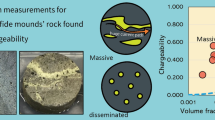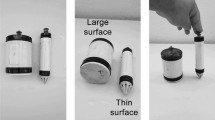Abstract
The induced polarization (IP) method can play an important role in the exploration of seafloor polymetallic sulfide deposits. Compared to frequency-domain IP, time-domain IP (TDIP) requires a simpler apparatus configuration and can be more widely and economically deployed for operations in seafloor environments. To investigate the effect of the seafloor environment on the TDIP measurement and find suitable parameters to characterize metallic bodies, laboratory experiments on synthetic samples were carried out based on a special electrical experimental system. The time-domain Cole–Cole model and relaxation time distribution (RTD) method were combined to process and interpret the measured data. The results show that the volume content of metallic minerals in ore-bearing rocks can be directly quantified by the total chargeability. The sizes of metallic particles can be approximately determined by the relaxation time defined from the peak of the RTD. The RTD method was used to distinguish multiple polarizable sources, such as sulfide and basalt. TDIP surveying in the marine environment is more efficient than surveying in the terrestrial environment. A short time delay used before starting secondary voltage measurements is more suitable for a successful TDIP survey in a high-salinity environment. In addition, the chargeability is shown to be more sensitive to the variation in the volume content of metallic minerals than the direct current resistivity.













Similar content being viewed by others
Data availability
Data associated with this research are available and can be obtained by contacting the corresponding author.
References
Berryman JG (1995) Mixture theories for rock properties. Rock Physics and Phase Relations: A Handbook of Physical Constants. Am Geophys 3:205–228
Chen J, Hubbard SS, Williams KH, Orozco AF, Kemna A (2012) Estimating the spatiotemporal distribution of geochemical parameters associated with biostimulation using spectral induced polarization data and hierarchical Bayesian models. Water Resour Res. 48. https://doi.org/10.1029/2011wr010992
Florsch N, Llubes M, Tereygeol E, Ghorbani A, Roblet P (2011) Quantification of slag heap volumes and masses through the use of induced polarization: application to the Castel-Minier site. J Archaeol Sci 38:438–451. https://doi.org/10.1016/j.jas.2010.09.027
Glasby GP (2002) Deep seabed mining: past failures and future prospects. Mar Georesour Geotechnol 20:161–176. https://doi.org/10.1080/03608860290051859
Glover PW, Hole MJ, Pous J (2000) A modified Archie’s law for two conducting phases. Earth Planet Sci Lett 180(3–4):369–383
Goto T N et al (2011) Marine electromagnetic sounding on submarine massive sulphides using remotely operated vehicle (ROV) and autonomous underwater vehicle (AUV). Proceedings of the 10th SEGJ International Symposium. Society of Exploration Geophysicists of Japan, 2011
Gurin G, Tarasov A, Ilyin Y, Titov K (2013) Time domain spectral induced polarization of disseminated electronic conductors: laboratory data analysis through the Debye decomposition approach. J Appl Geophys 98:44–53. https://doi.org/10.1016/j.jappgeo.2013.07.008
Gurin G, Titov K, Ilyin Y, Tarasov A (2015) Induced polarization of disseminated electronically conductive minerals: a semi-empirical model. Geophys J Int 200:1555–1565. https://doi.org/10.1093/gji/ggu490
Hannington M, Jamieson J, Monecke T, Petersen S, Beaulieu S (2011) The abundance of seafloor massive sulfide deposits. Geology 39:1155–1158. https://doi.org/10.1130/g32468.1
Hashin Z, Shtrikman S (1962) A variational approach to the theory of the effective magnetic permeability of multiphase materials. J Appl Phys 33(10):3125–3131
Haroon A, Hölz S, Gehrmann RAS, Attias E, Jegen M, Minshull TA, Murton BJ (2018) Marine dipole–dipole controlled source electromagnetic and coincident-loop transient electromagnetic experiments to detect seafloor massive sulphides: effects of three-dimensional bathymetry. Geophys J Int 215:2156–2171. https://doi.org/10.1093/gji/ggy398
Hoagland P, Beaulieu S, Tivey MA, Eggert RG, German C, Glowka L, Lin J (2010) Deep-sea mining of seafloor massive sulfides. Mar Policy 34:728–732. https://doi.org/10.1016/j.marpol.2009.12.001
Hupfer S, Martin T, Weller A, Guenther T, Kuhn K, Ngninjio VDN, Noell U (2016) Polarization effects of unconsolidated sulphide-sand-mixtures. J Appl Geophys 135:456–465. https://doi.org/10.1016/j.jappgeo.2015.12.003
Kemna A, Binley A, Cassiani G, Niederleithinger E, Revil A et al (2012) An overview of the spectral induced polarization method for near-surface applications. Near Surf Geophys 10:453–468. https://doi.org/10.3997/1873-0604.2012027
Komori S et al. (2017) Depth profiles of resistivity and spectral IP for active modern submarine hydrothermal deposits: a case study from the Iheya North Knoll and the Iheya Minor Ridge in Okinawa Trough, Japan. Earth Planets Space. 69. https://doi.org/10.1186/s40623-017-0691-6
Kumar I, Kumar BVL, Babu RV, Dash JK, Chaturvedi AK (2019) Relaxation time distribution approach of mineral discrimination from time domain-induced polarisation data. Explor Geophys 50:337–350. https://doi.org/10.1080/08123985.2019.1606198
Lesmes DP, Frye KM (2001) Influence of pore fluid chemistry on the complex conductivity and induced polarization responses of Berea sandstone. J Geophys Res Solid Earth 106:4079–4090. https://doi.org/10.1029/2000jb900392
Lipton I (2008) Mineral resource estimate Solwara 1 project Bismarck Sea Papua New Guinea for Nautilus Minerals Inc. Golder Associates
Liu X, Kong L, Zhang P, Zhou K (2014a) Permeability estimation using relaxation time spectra derived from differential evolution inversion. J Geophys Eng 11:015006. https://doi.org/10.1088/1742-2132/11/1/015006
Liu X, Kong L, Zhou K, Zhang P (2014b) A time domain induced polarization relaxation time spectrum inversion method based on a damping factor and residual correction. Pet Sci 11:519–525. https://doi.org/10.1007/s12182-014-0367-9
Mitchley M, Sears M (2014) Searching for seafloor massive sulfides: a quantitative review of high-resolution methods in deep sea sonar bathymetry for mining applications. Mar Geophys Res 35:157–174. https://doi.org/10.1007/s11001-014-9219-7
Nai C et al (2019) Complex resistivity characteristics of saltwater-intruded sand contaminated by heavy metal. Sci Rep 9:10944. https://doi.org/10.1038/s41598-019-47167-8
Pelton WH, Ward S, Hallof P, Sill W, Nelson PH (1978) Mineral discrimination and removal of inductive coupling with multifrequency IP. Geophysics 43:588–609
Qi Y, Ahmed AS, Revil A, Ghorbani A, Abdulsamad F, Florsch N, Bonnenfant J (2018) Induced polarization response of porous media with metallic particles—part 7: detection and quantification of buried slag heaps. Geophysics 83:E277–E291. https://doi.org/10.1190/geo2017-0760.1
Revil A, Aal GZA, Atekwana EA, Mao D, Florsch N (2015) Induced polarization response of porous media with metallic particles—part 2: comparison with a broad database of experimental data. Geophysics 80:D539–D552. https://doi.org/10.1190/geo2014-0578.1
Revil A, Mao D, Shao Z, Sleevi MF, Wang D (2017) Induced polarization response of porous media with metallic particles—part 6: the case of metals and semimetals. Geophysics 82(2):E97–E110
Revil A, Coperey A, Mao D, Abdulsamad F, Ghorbani A, Rossi M, Gasquet D (2018) Induced polarization response of porous media with metallic particles. Part 8: Influence of temperature and salinity. Geophysics 83:E435–E456. https://doi.org/10.1190/geo2018-0089.1
Rona PA et al (1993) Active and relict sea-floor hydrothermal mineralization at the TAG hydrothermal field, Mid-Atlantic Ridge. Econ Geol 88:1989–2017
Slater LD, Choi J, Wu YX (2005) Electrical properties of iron-sand columns: implications for induced polarization investigation and performance monitoring of iron-wall barriers. Geophysics 70:G87–G94. https://doi.org/10.1190/1.1990218
Spagnoli G, Hannington M, Bairlein K, Hoerdt A, Jegen M, Petersen S, Laurila T (2016) Electrical properties of seafloor massive sulfides. Geo Mar Lett 36:235–245. https://doi.org/10.1007/s00367-016-0439-5
Tao C et al (2017) Hydrothermal plume mapping as a prospecting tool for seafloor sulfide deposits: a case study at the Zouyu-1 and Zouyu-2 hydrothermal fields in the southern Mid-Atlantic Ridge. Mar Geophys Res 38:3–16. https://doi.org/10.1007/s11001-016-9275-2
Tao C et al (2020) Deep high-temperature hydrothermal circulation in a detachment faulting system on the ultra-slow spreading ridge. Nat Commun 11:1300. https://doi.org/10.1038/s41467-020-15062-w
Tong MS, Wang WN, Li L, Jiang YZ, Deqin S (2004) Estimation of permeability of shaly sand reservoir from induced polarization relaxation time spectra. J Petrol Sci Eng 45:1–10. https://doi.org/10.1016/j.petrol.2004.05.007
Tong M, Li L, Wang W, Jiang Y (2006) Determining capillary-pressure curve, pore-size distribution, and permeability from induced polarization of shaley sand. Geophysics 71:N33–N40. https://doi.org/10.1190/1.2195989
Veeken PCH, Legeydo PJ, Davidenko YA, Kudryavceva EO, Ivanov SA, Chuvaev A (2009) Benefits of the induced polarization geoelectric method to hydrocarbon exploration. Geophysics 74:B47–B59. https://doi.org/10.1190/1.3076607
Vidal O, Rostom F, Francois C, Giraud G (2017) Global trends in metal consumption and supply: the raw material-energy nexus. Elements 13:319–324. https://doi.org/10.2138/gselements.13.5.319
Weller A, Breede K, Slater L, Nordsiek S (2011) Effect of changing water salinity on complex conductivity spectra of sandstones. Geophysics 76:F315–F327. https://doi.org/10.1190/geo2011-0072.1
Yuan B, Yang Y, Yu H, Zhao Y, Ding Q, Yang J, Tang X (2018) Geochemistry of pyrite and chalcopyrite from an active black smoker in 49.6A degrees E Southwest Indian Ridge. Mar Geophys Res 39:441–461. https://doi.org/10.1007/s11001-017-9324-5
Zhang P, Wang S, Zhou K-B, Kong L, Zeng H-X (2016) Research into the inversion of the induced polarization relaxation time spectrum based on the uniform amplitude sampling method. Pet Sci 13:64–76. https://doi.org/10.1007/s12182-015-0074-1
Funding
This work was supported in part by the National Natural Science Foundation of China under Grant 41874215, and in part by the COMRA Major Project under contract no. DY135-S1-01-06.
Author information
Authors and Affiliations
Contributions
All authors contributed to the study conception and design. Material preparation was performed by Tao Wu. Measurement and data analysis were performed by Caowei Wu. Original draft of the manuscript was written by Caowei Wu and Changchun Zou and reviewed and edited by Luyi Shen, Jianping Zhou and Chunhui Tao. All authors read and approved the final manuscript.
Corresponding author
Ethics declarations
Conflict of interest
The authors have no conflicts of interest to declare that are relevant to the content of this article.
Additional information
Publisher's Note
Springer Nature remains neutral with regard to jurisdictional claims in published maps and institutional affiliations.
Appendix
Appendix
Inversion of the relaxation time distribution
The time-domain IP phenomenon of a porous material with metallic particles is a superposition of individual relaxations caused by various polarizable elements. The induced polarization decay can be expressed mathematically as a weighted superposition of a series of exponential decays \({e}^{\frac{-t}{\tau }}\) with different time constants \({\tau }_{i}\) (Tong et al. 2004, 2006). Hence, the measured induced polarization decay curve can be described as follows:
where G(τ) is the nonnegative weight coefficient relating to \({\tau }_{i}\). \({\tau }_{min}\) is the shortest relaxation time. \({\tau }_{max}\) is the largest relaxation time. For the numerical computation of G(τ), Eq. 1 needs to be discretized into a matrix equation.
where
\({A}_{n\times m}\) is the dimensional coefficient matrix of kernel \({e}^{\frac{-{t}_{n}}{{\tau }_{m}}}\). \({t}_{n}\) denotes the time moment of recording the secondary voltage. \({b}_{n\times 1}\) is the discrete column vector of the normalized secondary voltage, and \({x}_{m\times 1}\) is the solution column vector, which represents the dimensional amplitude G(τ) of the relaxation time constant \({\tau }_{m}\). \({\tau }_{m}\) (m = 1, 2, 3…, \(i\)) are relaxation time constant series determined from \({\tau }_{min}\) to \({\tau }_{max}\) in advance. The solution vector \(x\) is sensitive to the noise of the TDIP data.
The generalized inverse of Eq. 2 is
However, the solution of this equation is greatly affected by the signal-to-noise ratio, and a small noise effect of the secondary decay curve could lead to a large deviation of the result \(x\). This problem can be solved by using a regularized least squares method (Liu et al. 2014a). The new equation can be expressed as:
where \(\lambda\) is the regularization parameter and \(W\) is the regularization operator corresponding to a specific constraint matrix. The regularization operator is the unit matrix in our study, so the optimization problem is solved based on the minimum length model. Then, the solution of Eq. 6 can be expressed as follows:
Then, we solve Eq. (7), and the relaxation distribution (\({\tau }_{m}, x\)) is computed. The G(τ) calculated in our study is a series of discrete values corresponding to the \({\tau }_{m}\). To present the results visually, a solid line is used to connect these discrete points on the graph.
Rights and permissions
About this article
Cite this article
Wu, C., Zou, C., Wu, T. et al. Experimental study on the detection of metal sulfide under seafloor environment using time domain induced polarization. Mar Geophys Res 42, 17 (2021). https://doi.org/10.1007/s11001-021-09438-w
Received:
Accepted:
Published:
DOI: https://doi.org/10.1007/s11001-021-09438-w




